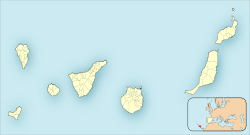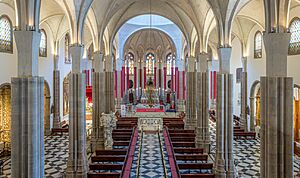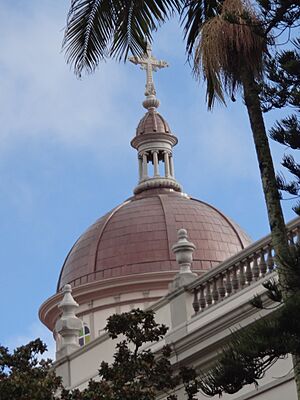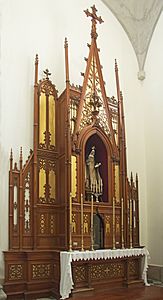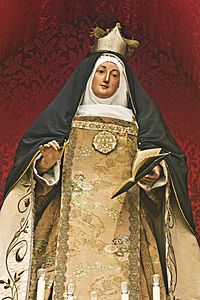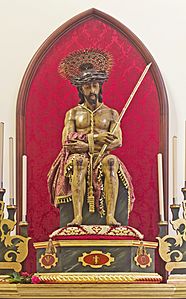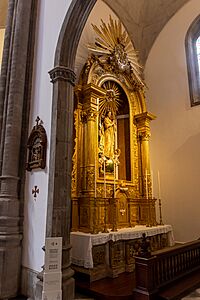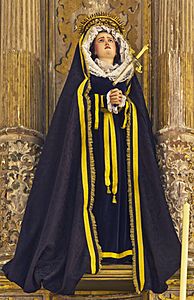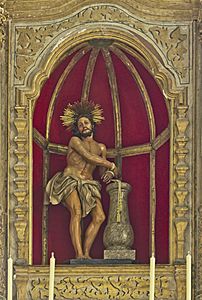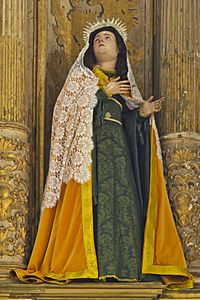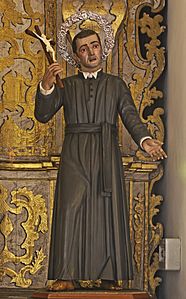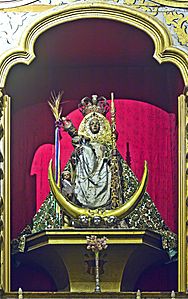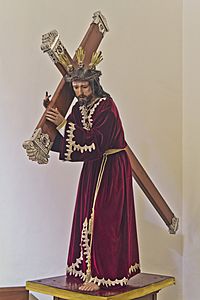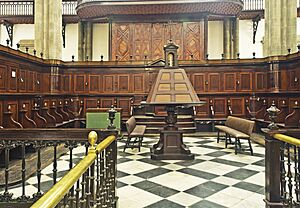Cathedral of La Laguna facts for kids
Quick facts for kids Cathedral of San Cristóbal de La Laguna |
|
|---|---|
|
Catedral de San Cristóbal de La Laguna
|
|
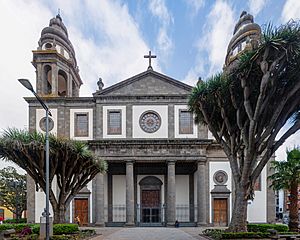
West façade.
|
|
| 28°29′20″N 16°18′59″W / 28.48889°N 16.31639°W | |
| Location | San Cristóbal de La Laguna, Tenerife |
| Country | Spain |
| Denomination | Catholic Church |
| Website | Official Website: http://lalagunacatedral.com/ |
| History | |
| Status | Cathedral |
| Architecture | |
| Architectural type | Church |
| Style | Neoclassical, Neo-Gothic |
| Groundbreaking | 1904 |
| Completed | 1915 |
The Cathedral of San Cristóbal de La Laguna is a large Catholic church in Tenerife, Spain. It is also known as the Catedral de Nuestra Señora de los Remedios in Spanish. This important building was built between 1904 and 1915. It replaced an older church that had been there since 1515. In 1818, it became a cathedral.
The cathedral is dedicated to the Virgin of Los Remedios. She is the patron saint of the Roman Catholic Diocese of San Cristóbal de La Laguna and the island of Tenerife. As the main church of the diocese, it is where the bishop has his official seat. The diocese includes the islands of Tenerife, La Palma, La Gomera, and El Hierro.
The Cathedral of San Cristóbal de La Laguna is in the city of San Cristóbal de La Laguna. Inside, you can find the remains of Alonso Fernandez de Lugo. He was the person who conquered the island and founded the city. The cathedral is part of the city's historic center. This area was named a World Heritage Site by UNESCO in 1999. The cathedral shows off different building styles, including Neoclassical and Neo-Gothic. It is famous for its Neoclassical front and its large dome.
Contents
History of the Cathedral
Early Churches
In 1511, a small chapel was built where the cathedral stands today. It was ordered by the conqueror, Alonso Fernández de Lugo. This area might have been an old burial ground for the Guanches, who were the native people of the island. The whole valley where the city is located was a special place for the island's first people.
This first chapel was dedicated to the Virgin Mary. In 1515, a bigger church was built in its place. This new church was dedicated to the Virgin of Los Remedios. A tower was added to it in 1618. On April 21, 1515, the church became a parish.
In 1534, Saint José de Anchieta was baptized in this church. He was born in La Laguna. He later became a missionary and helped found the cities of São Paulo and Rio de Janeiro in Brazil. The cathedral is a special place for this saint in the Canary Islands.
In 1752, the church was made larger. The main chapel and dressing rooms for the Virgin of Los Remedios were expanded. Don Domingo de la Guerra, who led this work, hoped the church would become a cathedral one day.
Becoming a Cathedral
For many years, people tried to make the Church of Los Remedios a cathedral. These early attempts were not successful.
Finally, on February 1, 1819, a special order from Pope Pius VII allowed the creation of a new diocese. The church officially became a cathedral in 1819. This new diocese of La Laguna covers the islands of Tenerife, La Palma, La Gomera, and El Hierro.
A priest named Cristóbal Bencomo y Rodríguez played a big part in making the church a cathedral. He was a close advisor to King Ferdinand VII of Spain. His tomb is now inside the Cathedral of La Laguna.
When it became a cathedral, La Laguna was the capital of the island. That is why the cathedral was built there, not in the current capital, Santa Cruz de Tenerife. The cathedral was declared a National Historic-Artistic Monument in Spain on October 5, 1983.
For a time, between 1851 and 1875, the Bishopric of Tenerife was closed. During this period, the Cathedral of La Laguna lost its cathedral title. It became a collegiate church. When the diocese was restored in 1875, the church became a cathedral again.
The cathedral is also a parish church and a special place for the Virgin Mary. The Virgin of Los Remedios is the patron saint of the diocese and Tenerife.
Restoration Work (2002–2014)
In 2002, the cathedral closed for a big restoration project. It was meant to reopen in a few years. However, due to some problems, it stayed closed for over ten years. During the study before the restoration, workers found that the main dome and ceilings were very damaged. They had to be taken down and rebuilt.
The new ceilings and domes were built using a new material called polypropylene fiber. This made the cathedral the first in the world to use this material. The cathedral finally reopened its doors on January 25, 2014. It was reopened for worship on January 31 of that year.
To celebrate the reopening, a special Jubilee Year was held from April 27, 2014, to April 12, 2015. This was approved by Pope Francis.
During the renovation, in 2014, old remains were found underground in Cathedral Square. These findings suggested there were structures from the first European settlement in the city. Later, in 2018, human remains from the 1500s were found. It is thought that an old church cemetery was located there.
Cathedral Architecture
The front of the cathedral, in the Neoclassical style, was built in 1820. The rest of the building, constructed between 1904 and 1915, is in the Neo-Gothic style. The cathedral has three wide aisles and a special walkway called an ambulatory. This walkway goes around the main altar. These features give the inside of the cathedral a feeling like older European churches.
The cathedral's large dome has a concrete cross on top. It is about 41.5 meters (136 feet) tall. This makes it the highest point in the old town. The ceilings have small windows that let in natural light. The dome is covered with copper plates, similar to cathedrals in central and northern Europe.
Chapels Inside the Cathedral
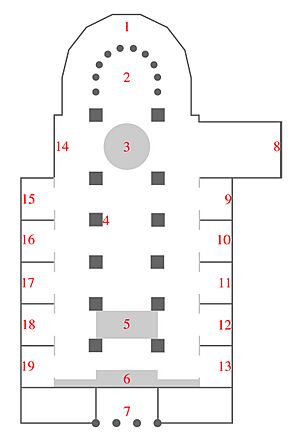
1- Ambulatory
2- High altar
3- Dome
4- Pulpit
5- Stalls of Cathedral Chapter
6- Organ loft
7- Portal
8- Chapel of Our Lady of Remedies
9- Chapel of the Immaculate Conception
10- Chapel of Saint Teresa of Avila
11- Side entrance on the street Obispo Rey Redondo (Calle de La Carrera)
12- Chapel of Our Lady of Mount Carmel
13- Chapel of Saint Barbara
14- Table of Souls in Purgatory
15- Chapel of Christ tied to the Column
16- Chapel of Our Lady of Candelaria
17- Side entrance down the street Bencomo
18- Chapel of Saint Joseph of Nazareth
19- Chapel of the Baptistery
The cathedral has many chapels, each with its own special artworks and history.
Chapel of Saint Teresa of Avila
This chapel has a Neo-Gothic altarpiece. In the middle is a statue of Saint Teresa of Avila. The chapel also holds an altarpiece of Ecce Homo, which is locally called Señor de la Cañita. It was placed there in March 2014 after the cathedral reopened.
Chapel of the Immaculate Conception
This chapel is dedicated to the Immaculate Conception. Its altarpiece was made in 1915. It was damaged during the cathedral's closure from 2002 to 2014 but has since been repaired. The sculpture Our Lady of Light is in this chapel. It dates back to the mid-1500s. The tomb of Bishop Nicolás Rey y Redondo is also here.
-
Stained glass windows depicting Saint Diego de Alcalá and Blessed Ignacio de Azevedo
Chapel of Christ Tied to the Column
The sculpture of Christ at the column in this chapel was made by Pietro Galleano in Genoa, Italy, in 1756. The altarpiece around it was carved and covered in gold between 1763 and 1765. Next to Christ are statues of Our Lady of Sorrows and Saint Mary Magdalene. The tomb of Bishop Luis Franco Cascón is also in this chapel.
Chapel of Our Lady of Candelaria
This chapel's altarpiece is dedicated to the Virgin of Candelaria. The statue of the Virgin of Candelaria is a copy of the patron saint of the Canary Islands. It was made by Faustino Álvarez Hernández. Statues of Canarian saints Saint José de Anchieta and Saint Peter of Saint Joseph de Betancur are also here.
Chapel of Our Lady of Remedies
The most important part inside the cathedral is the altarpiece of Our Lady of Remedies. She is the patron saint of the city, the island of Tenerife, and the Roman Catholic Diocese of San Cristóbal de La Laguna. Her feast day is celebrated on September 8.
The altarpiece is in a chapel within the cathedral and is the largest in the Canary Islands. It is a grand Baroque altarpiece from the early 1700s. It has seven impressive panels believed to be by Hendrick Van Balen. The statue of the Virgin of Los Remedios is in the center, dressed in rich robes and placed on a silver throne.
Other Artworks and Treasures
The cathedral also has a beautiful pulpit made of Carrara marble from Italy. It was carved by Pasquale Bocciardo. There are also valuable artworks by famous sculptors like Cristóbal Hernández de Quintana, Luján Pérez, and Fernando Estévez.
Inside, you can find the image of Christ of Los Remedios, which is very similar to the famous Cristo de La Laguna. This image is from the 1500s. The cathedral also has a large painting called The Souls of Purgatory by Cristóbal Hernández de Quintana, and a painting of the Last Supper by Juan de Miranda.
The cathedral keeps relics of several saints, including Saint Aurelio de Córdoba and Saint Faustino. Most importantly, it holds relics of the two saints from the Canary Islands: Peter of Saint Joseph Betancur and José de Anchieta.
The cathedral's treasure includes many valuable items from the 1500s to today. It has the largest collection of goldsmith pieces in the Canary Islands. This includes two silver candlesticks that are the largest in Spain.
Music in the Cathedral
After the Diocese of San Cristóbal de La Laguna was created and the church became a cathedral, it became a major center for music. A music chapel was formed. Miguel Jurado Bustamante, a composer from Cadiz, was the choirmaster. Other important composers who worked at the cathedral include Remigio Oliva, Manuel Fragoso, and Nicolás González.
Miguel Jurado Bustamante wrote many religious music pieces. He trained other local musicians, like Domingo Crisanto Delgado Gómez. Crisanto became a famous composer from the Canary Islands in the 1800s.
Chapter House and Icon Museum
The chapter house is where the cathedral chapter meets. This group of priests is in charge of the cathedral's religious and cultural activities. The building is an old Canarian house from the 1700s, connected to the cathedral.
It also houses the icons museum. This museum has the largest collection of Byzantine icons in Spain. There are 160 original pieces, most of them about 300 years old. These artworks belong to the Diocese of Tenerife. They came from countries like Russia, Romania, Yugoslavia, Italy, and Greece.
The La Laguna Cathedral is one of the few Catholic cathedrals in the world with a museum dedicated to Eastern Orthodox art.
Special Events and Celebrations
Many important religious events and celebrations take place in the cathedral. During Holy Week, the cathedral is a central point for the city's religious traditions. Different groups from the city come to the cathedral with their processional statues. One of the most important statues is the Cristo de La Laguna, which is highly respected in the Canary Islands. It comes to the cathedral every Holy Friday for a large procession.
The statue of Christ also visits the cathedral in September for special celebrations. In September, the feast of Our Lady of Remedies, the patron saint, is also celebrated on September 8. Another important event is the procession of Las Candelas on February 2, featuring the image of Our Lady of Candelaria. Other celebrations include the city's patron saint festival for Saint Christopher (July 27), the Corpus Christi procession, and the feast of Saint José de Anchieta on June 9.
Interesting Facts About the Cathedral
The Immurement of La Laguna Cathedral
In the past, some people, especially women, chose to live in small rooms next to the main altar of churches. This was a very strict form of religious devotion. They would connect to the church through a window to attend mass.
The old church, where the current Cathedral of La Laguna stands, had the only known case of this practice in the Canary Islands in the 1500s. A woman named Isabel de la Cruz lived this way. After she passed away, her niece, María de las Vírgenes, and then her great-niece, María Emerenciana, continued this tradition.
Vision of the Virgin of Los Remedios
John of Jesus Hernández y Delgado was a Franciscan friar in the 1600s. He lived outside the city walls of La Laguna. John of Jesus said he saw the Virgin of Los Remedios blessing the city from the top of the church tower, which is now the cathedral. This vision was shared during the friar's funeral.
Famous Baptisms
Some notable people were baptized in the old Church of Los Remedios. These include José de Anchieta in 1534, who became a saint and missionary in Brazil. Also, Amaro Pargo, a famous privateer and merchant, was baptized there in 1678.
Gallery
-
Tomb of Alonso Fernández de Lugo, conqueror of the island and city founder
See also
 In Spanish: Catedral de San Cristóbal de La Laguna para niños
In Spanish: Catedral de San Cristóbal de La Laguna para niños
- Roman Catholic Diocese of San Cristóbal de La Laguna
- Real Santuario del Santísimo Cristo de La Laguna
- Basilica of Candelaria
- San Cristóbal de La Laguna


